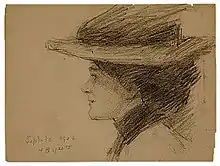
Mary Fanton Roberts (1864–1956) was an American journalist and writer. She was best known as an editor of women's and decorating magazines.[1] During her long career she was editor of the illustrated monthly Demorest's, editor-in-chief of New Idea Woman's Magazine, managing editor of The Craftsman, and creator and editor of The Touchstone and Decorative Arts magazine.[2] She often wrote articles on the topic of decorative arts and home decorating, and published two books, Inside 100 Homes and 101 Ideas for Successful Interiors.[3] She was also an avid gardener.[4] She occasionally wrote criticism under the pen name, Giles Edgerton.[2]
Biography
Roberts was born in Brooklyn, New York, but moved as a young girl to Deadwood, in the Montana territory.[5] When she was old enough, she and her sister were sent back to New York to attend the Albany Female Academy.[6] After finishing school, Roberts pursued journalism and became a staff writer for four years for the Herald Tribune, the Journal, and The Sun in New York City. Her first assignment as a reporter was to interview Hetty Green and the article she wrote about her was "so successful that it launched her into what was to be a lifetime career."[6]
Roberts was very much involved in the artistic, theatrical, and literary circles in New York City, and she became friends with many American avant-garde artists.[6] Roberts was responsible for helping to launch many artists' careers.[7] She was active in organizations such as the Women's City Club, Pen and Brush, and the MacDowell Society. As an avid supporter of modern dance, she became close to many performers, including Isadora Duncan and Angna Enters.
She married William Carman Roberts in 1906.[8]
During WWI, she and Paris Singer helped establish a hospital for soldiers with "shell shock" to convalesce in Palm Beach.[9][10] Roberts used her platform as an editor to raise awareness of the issue and support the hospital.[9][10]
Roberts moved to the Chelsea Hotel in 1941, where she lived for the rest of her life. She maintained lifelong relationships with a wide circle of friends and continued to correspond with them and attend social events until her death.[3]
Writing
Roberts' book, Inside 100 Homes (1937), is about the decoration of homes and is illustrated with numerous photographs.[11] The Indianapolis Star wrote that Inside 100 Homes was "a book to fit the new spirit of life."[12]
References
Citations
- ↑ "Mrs. Mary Fanton Roberts". Chicago Tribune. October 15, 1956. Retrieved August 19, 2017 – via Newspapers.com.
- 1 2 Kinhart, Erin (March 19, 2012). "Piecing Together a Biography: Who Was Mary Fanton Roberts?". The Primary Source. Smithsonian Archives of American Art. Retrieved August 19, 2017.
- 1 2 "Revolt, They Said". www.andreageyer.info. Retrieved 17 August 2017.
- ↑ Dennen, Ruth (July 6, 1919). "Here's Proof that Every Business House Should Have a Garden". New-York Tribune. Retrieved August 19, 2017 – via Newspapers.com.
- ↑ Corley, Erin. "Biographical Note". A Finding Aid to the Mary Fanton Roberts Papers, 1880–1956, in the Archives of American Art. Smithsonian Archives of American Art. Retrieved August 19, 2017.
- 1 2 3 M.K.P. 1964, p. 10.
- ↑ "Mrs. Mary Fanton Roberts". The Cincinnati Enquirer. October 15, 1956. Retrieved August 19, 2017 – via Newspapers.com.
- ↑ M.K.P. 1964, p. 11.
- 1 2 Cull, Donald W. (January 30, 1983). "The Building of the Everglades Club". The Palm Beach Post. Retrieved August 19, 2017 – via Newspapers.com.
- 1 2 "Paris Singer Tells of His Palm Beach Development Plans". The Palm Beach Post. July 15, 1918. Retrieved August 19, 2017 – via Newspapers.com.
- ↑ Selby, John (January 5, 1937). "The Literary Guidepost". Abilene Reporter-News. Retrieved August 19, 2017 – via Newspapers.com.
- ↑ "Every Lover of a Beautiful Home Will Prize New Book". The Indianapolis Star. January 17, 1937. Retrieved August 19, 2017 – via Newspapers.com.
Sources
External links
![]() This article incorporates text from a free content work. Licensed under CC BY-SA 3.0. Text taken from Revolt They Said, Andrea Geyer, .
This article incorporates text from a free content work. Licensed under CC BY-SA 3.0. Text taken from Revolt They Said, Andrea Geyer, .